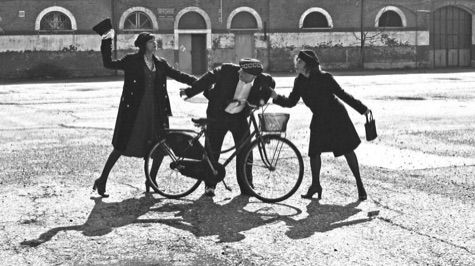LUCK FAVORS THE WELL PREPARED
A successful (i.e. enjoyable) granfondo experience is not something one does on a lark and cannot be improvised on the spur of the moment; It is the result of concentration, careful planning, and preparation: physical, mental, logistical, and material (equipment). A professional attitude and attention to detail distinguish riders who are always prepared, confident, and on top of things from those who always seem to get themselves in trouble. I once had three friends, members of the same family, who were good, experienced cyclists, but frequently found themselves in difficult, unpleasant, even ridiculous situations, which were the direct result of their cavalier attitude and lack of foresight and preparation: wearing a sleeveless skinsuit to ride the Sella Ronda, forgetting shoes, neglecting to bring jackets, not knowing how to fix a flat and complaining that no one stopped to help..
Needless to say, don't even think of entering a granfondo if you lack the proper training and fitness (at least 2000 km/1200 miles of training, including plenty of climbing, are recommended), if you hate climbs, are afraid of technical descents with switchbacks, or are uncomfortable riding in a very large group.
REGISTRATION
Procedures may differ from one event to another. There are some famous granfondos that you can usually enter a month or two before, and others, such as the Maratona dles Dolomites and Nove Colli, which have over 9,000 riders, which you must try to enter months before--places are allotted by lottery (about 30,000 applicants for around 9,000 places)! Some smaller local rides can be entered even on the morning of the event, but others, for logistical reasons, must be entered well ahead of time. Make sure that you read attentively the regulations of any event you intend to enter. Most well known granfondos offer online registration and payment by credit card. (In the "old days," before widespread internet usage, payment was by bank transfer or cash payment at any (Italian) post office, to the organizers' postal account, which works like a bank account). The registration form will ask for the number of your cycling federation license (often translated as card). If you don't have one, you will need to provide a letter from your doctor certifying that you are fit to engage in competitive cycling, and pay a surcharge for a one-day license (which includes insurance).
TIPS
1. Make sure you keep the receipts for your registration and payment, and take them with you when you go to pick up your race packet containing your numbers and other material. Occasionally, entries get lost or misplaced, and you'll need proof that you registered. (It happened to me on one occasion).
2. "Chips" (timing transponders) may be obtained at a separate stand in the packet pick-up area. You'll need to tell the personnel your race number so they can link it electronically to the code of the chip they give you. The Maratona has chips incorporated into the race numbers that get mounted on the handlebars. You will pay a security deposit which will be returned to you when you turn in the chip.
3. Pick up your race packet the day before the event, not the night before, or worse, the morning of it. I always liked to arrive at the departure locale with my numbers already zip-tied to my handlebars (it needs to be visable so do not wrap it around your head tube) and pinned to my jersey, and my timing chip mounted on my bike. These and other pre-race rituals are best carried out in advance in a calm atmosphere, not just before the start. The less you have to think about and do on race morning, the better. This GCN video covers what not to do before any big ride.
4. You will probably find a buono pasto (meal coupon) and sometimes a separate buono bevanda (drink coupon) in your race packet. Tuck these in your wallet so you'll be sure to have them for the pasta party that follows the race. Coupons are sometimes given out when you return your timing chip. (Don't leave your wallet in your car! Thieves love it when cyclists do this.)
TERMINOLOGY
If you are registering for a granfondo, other organized ride, or race, here are some terms you need to know:
iscrizione - registration, sign up
pacco gara - race packet
pettorale - the race number that you pin on the back of your jersey
ritiro - pick-up, that is, of the race packet containing your numbers and other material
cauzione - security deposit, required when picking up your timing chip
ritrovo - ritrovo partenza is the time and place at which riders assemble for the start of the event. In a ride or race without pre-registration, ritrovo means the time and place where registration is held.
nome - first name; cognome - last name
indirizzo or residente a - address
data di nascita - birthdate
luogo di nascita - birthplace
sesso - gender
cittadinanza/nazione - citizenship/the country where you reside
ente - the federation (FCI, ACSI, USA Cycling, etc.) which issued your racing license
card - federation license
società - club or team
numero tessera - the number of your racing license (tessera means membership card).
codice società - club/team code number
codice chip - the number of your timing chip
taglia maglia - jersey size
salopette - bib shorts
griglia -starting grid
partenza - start, start line
arrivo - finish line
STUDY THE COURSE!
Familiarizing yourself with the course is an essential part of preparation.
• On the event website, you'll find a course map.
• Take note also of where the mechanics' stations (assistanza meccanica) are located, and more importantly, where the feeding areas (ristori) are: it can be comforting to know that there's food and drink (and a chance to rest) not far ahead. Of course, if you are really hard up, you can stop at any bar or water fountain, and the support vehicles carry water as well. Included in your race pack there may also be a course info sheet that indicates potentially hazardous descents and intersections, as well other situations you should be aware of.
• If you're coming from afar, you probably won't have a chance to recon the course like the pros sometimes do, but you can learn a lot from Google Street View, You'll feel more confident if you are somewhat familiar with the territory and lay of the land.
• If there's a GPX file of the course, download it to your GPS bike computer (assuming you have one with with maps and navigation, of course). This is helpful for a couple of reasons. Since almost all granfondos offer more than one course, and they usually follow the same route for some distance, it's critical to know at which point they divide. There will be signs along the route warning you ahead of time, as well as at the actual division point (and perhaps marshals as well), but it's a good idea to have it already fixed in your mind (and to pay attention!) so you won't find yourself surprised and momentarily confused. A bike computer with navigation will give you a heads up so you can be ready and properly positioned in the pack. An acquaintance of mine was not paying attention at an intersection and kept following the group he was with. Several kilometers later he realized that he had turned onto the short course, whereas he'd intended to do the long one. By the time he got back, the faster riders were up the road, and he found himself in a group unable to ride at his desired pace. He had a choice of either slowing down or riding on alone. I once found myself on the right side of the pack at the point where I needed to make a left turn onto the short course; I had to stop and wait for the entire field to pass before I could cross over.
A GPS with maps and navigation is also helpful in the event that directional signs are missing. In the first edition of the GF Pinarello (1997, pre-GPS) I found myself at a crossroads with no indication of which way to go, After much time-consuming deliberation, I made an educated guess which fortunately proved correct. On another occasion I got "lost" going through the city of Belluno (again, due to missing course signs), and by the time I found my way out of the city, there was no sense in doing the out-and-back climb to the feeding stop, since the riders would be coming back down by the time I reached the top. The course marshals took pity on me and gave me a meat sandwich that was so vile and disgusting that I surreptitiously threw it down the drain. The organizers had been concerned about me when they didn't see me at the top, and were relieved to find me waiting for them when they came back down. They felt really bad when they realized they hadn't done a good job signing the route.
• There may also be a "time gate" at the course division point; if you don't reach it by a certain time (which is stated in the regulations), you will not be permitted to do the long course and will be directed onto the shorter one. (The Maratona has three courses and two such cancelli -- gates)
• Be aware also of the time limit (tempo massimo). If you don't reach a designated point by the prescribed time, you will be considered out of the event and on your own, and will no longer be entitled to assistance or provided with marshaling at intersections. Vehicles will begin flooding the course. The feeding stations will have closed up shop too.
Try to talk with riders who know the event, and follow their advice. The courses are usually the same from year to year, so they have a big advantage--both psychological and physical--in knowing what gear to take, what to expect, how to pace yourself, and so on. For example, learn if there are climbs that begin immediately after descents (as all of the Sella Ronda climbs in the Maratona dles Dolomites do). In such cases, if you are wearing a jacket on the descent, it's adviseable to stop to remove it before reaching the bottom and starting up the climb. Otherwise you will immediately overheat, and if you stop, it will be very difficult to get going again, especially if there are a lot of riders.
All this advice might seem obvious, but when you are experiencing unfamiliar situations in a foreign country, stress and anxiety can cause normal common sense and thought processes to go out the window. And there are some clueless riders out there. An acquaintance of mine who works for Pedale Feltrino, the GF Sportful organizers, once told me that the English were particularly matti--crazy. Perhaps because they are hardy from riding in the bad weather so prevalent in their country, but inexperienced at mountain riding, they set out without so much as a lightweight jacket (needed on descents if nothing else). Several years ago the broom wagon came upon a nearly naked rider, wet and shivering, in a tunnel. He wanted to continue riding and they had to force him to get in, for his own good. Which brings me to...
WHAT TO TAKE ON THE RIDE
Helmets are obligatory, of course. In the least, take what you'd take on any ride: a spare tube (or two), tire levers, pump or inflators, and a water bottle or two. I always take a snack, in the least a couple of "energy" bars, perhaps even a little prosciutto and cheese sandwich. The feeding stations offer sandwiches, fruit, little cakes and tarts, water, and Enervit or similar electrolyte drinks, which are referred to as sali, meaning "salts." However, they could run out of sandwiches, and I recall one year when the organizers of the GF Campagnolo forgot to set up the feeding station at the designated location on the short course! Fortunately, I had my own food, but others were not so (over) prepared. Events in the mountains, even in the heart of the summer, require some forethought and careful preparation. The Sportful Dolomiti Race (ex GF Campagnolo), usually held on the third weekend in June, is famous for cold and bad weather; riders on the long course have encountered snow on the passes, and the course has even had to be shortened on several occasions. Summer in Italy can mean scorching temperatures and high humidity, and even if there are numerous feeding stations, two water bottles are advise. I recall going through 6 bottles or more in the 130 km (80 mile) GF Pinarello, and I wouldn't have wanted to run out of water before the next stop. And don't forget the sun screen.
• Event organizers will often post the weather predictions and any weather advisories riders should know about, so there's no excuse to be unprepared. The Maratona dles Dolomites, for one, will text you the weather report if you sign up for this service.
DURING THE RACE
Granfondo starts are not for the faint-hearted. Everyone takes off at a frenzied pace, with riders who started in the back jockeying to get to the front. Speeds will reach 40 kph (25 mph) and higher. Be alert for crashes. I recall one addtion of the GF Pinarello when a fallen rider suddenly came sliding across the road just in front of me. Don't make any lateral moves without first checking with your peripheral vision. Don't try to keep up with groups you know are going too fast for you. If you're in a group that's going too slow, don't try to bridge the gap to a group ahead; instead, wait for a faster group to pass and jump on the back. Riding intelligently, which includes using your energy resources wisely, is one of the most important granfondo riding skills.
Cars will be pulled over for the race to pass, but be alert for protruding vehicles, the occasional confused, clueless, or self-important motorist, and other dangers. Marshals stop vehicles at intersections, but be watchful, just in case. In the mountains, roads may be closed to all traffic except for official race vehicles, but somehow, autos occasionally wind up on the course. Several 2024 GF Sportful competitors were seriously injured while descending the Forcella Franche (a small mountain pass), when an elderly woman, hell-bent on getting to church services in the tiny village at the top of the pass, ignored the marshals and drove right up the mountain, causing a head on-collision,
There will be signs informing you when are nearing a ristoro (feeding station) or assistenza meccanica (mechanical assistance station). Keep in mind that support vehicles are always in circulation (except at the Maratona), ready to help in the case of injury or illness (assistenza sanitaria), mechanical misfortune, thirst, or plain old exhaustion. In the 2002 GF Campagnolo I was so hot on the way up Croce d'Aune that I had to stop for several moments; a van immediately pulled over and the driver asked if I was ok, then kindly poured water over my head. The previous year a support vehicle suddenly stopped up ahead and an older gentleman whom I knew from having ridden his club's granfondo, jumped out, ran alongside me, and handed me a little bottle filled with hot coffee. At the GF Pinarello I had a cramp in my foot, and at a feeding stop I sat down on a guardrail and took off my shoe; one of the volunteers ran over and massaged my foot! The local volunteers are excited and enthusiastic about being a part of the event; they are exceedingly kind and supportive, and it gives them great pleasure to help the riders in any way they can. A smile and a "grazie" from you will be appreciated. You will become one of their pleasant and rewarding granfondo memories.
When I first started riding granfondos, a my friend Ivana gave me two important bits of advice: one, you must get used to being in the saddle for many long hours, and two, eat-eat-eat and drink-drink-drink. It's essential that you eat and drink enough of the right things at the right times, both for energy and (if the temperature is low), for warmth. Just a slight drop in blood sugar can drastically reduce your thought processes, as well as your physical output. As everyone knows, by the time you feel hunger or thirst, it's too late. I recall a granfondo in the Euganean Hills on a very hot, humid August day. I was on the 175 km course and found myself in last place along with a young man from Trieste. There were long windy stretches out on the flats and I was doing all the work. I kept motioning for him to pull but he would not, offering no excuse. I began to fear that when we got to the finish line he would sprint past me and make me finish dead last. I tried unsuccessfully to drop him on a little hill. Finally we reached the line and my fears were unfounded. Without a glance at the Triestino I headed off to wash and change, then went to the big tent and got my lunch. One of the organizers offered me a beer. He told me he'd been driving behind us and had watched me towing the fellow for miles and miles. "That young chap was completely dehydrated and suffering from heat exhaustion. He practically collapsed after the finish. We gave him a lot to drink but we were still worried about him and took him to the hospital." And there I'd been, trying to drop the poor guy! Luckily he didn't drop dead trying to stay on my wheel. If only he'd spoken up, I would have been more kind. Don't ever let yourself get into such a state!
On a stage of the 2004 Giro delle Dolomiti, I arrived on the Passo Falzarego, after having already ridden over the Fedaia (by the "easy" side from Canazei) and the killer Giau, and with the Pordoi still ahead. I sat down on a bench and started eating. My buddy Stefano arrived some time later, really wiped out. He went in the bar and ordered...a coffee...and nothing else. On the way up the Pordoi, he waved to me as he passed in the sag wagon. Later he said to me, "Next year I have to train more." I replied, "No, Stefano, you have to eat more!"
You need to experiment to find out which foods and supplements agree with you and produce the best results. I prefer separate electroyte and carb supplements: when it's hot and I need to drink more, I want additional electrolyes but not extra carbs, which can lead to gastric distress and bloating. I like to eat solid foods as well, especially raisins, nuts, Grana Padano cheese (it's very satisfying, and the protein is important), granola bars, and Molino Bianco Grancereale, which are oatmeal-like cookies. To each his own.
Tip: do not eat on climbs--the digestion process draws blood away from your hard-working muscles and can put you in a seriouly debilitated state. Eating at the top of a climb gives your body time to process carbs during the descent, so you'll be ready for the next ascent.
Warning: no matter what you may see other cyclists do, do not throw bar and gel wrappers, plastic bottles, cups, or other trash on the ground. Not only is it unsportsmanlike and contrary to the ecological ideals of cycling, but you will disqualified if you are seen by race officials. This has happened.
THE MENTAL ASPECT
Over 20 years of granfondo riding taught me that mental conditioning is every bit as important as physical conditioning. Riding a granfondo requires determination, perseverence, self-confidence, a strong will, and the ability and willingness to endure--even embrace--suffering. Italians have a word for this: grinta. (A person possessing these qualities is said to be grintoso (masc.) or grintosa (fem.).
In the past, I'd totally underestimated my capabilities. I'd done flat centuries, but never believed I could do a 100-mile course with several mountain passes. Riding granfondos spurred me to do rides I would not have attempted on my own--and had I tried, I probably would have weenied out when the going got tough, confirming, in a self-fulfilling prophecy, that I was not cut out for this sort of thing. But wanting to finish the events kept me going, and in the process, I learned how tenacious I could be and that I possessed more strength and endurance than I'd ever imagined (but not speed, alas). The resulting self-confidence enabled me to complete many difficult granfondos. When you're standing on the starting line, there must not be the slightest doubt in your mind that you will succeed. When a difficult climb looms ahead, you can't wonder if you can do it. Such doubt only leads to emotional, and ensuing physical, distress. Instead, you need only tell yourself that you've been in this situation before, and know that you can do it...then grit your teeth and get to it. You may be suffering, but the fire inside will keep you going. When you believe in yourself, nothing can stop you*...except a simple lack of will: Sure you can do it--but do you really want to? "Chi mi fa fare," you will hear cyclists say: Who is making me do this? What do I have to prove? If you start thinking like this, it's all over.
*assuming, of course, that you are adequately trained and fit
PHOTO MEMORIES
What cyclist wouldn't like a photo of herself in action against a dramatic backdrop? Photo services are in attendance at most major granfondos, with photographers stationed at several picturesque points along the course. In the "old days" studios actually sent the photos to your home, and you sent payment for the photos you wanted to keep and returned the rest. Others sent a proof sheet. It was sometimes months before you received your photos! Now of course the photo studios put them on their websites, where you can view them and order the ones you want. Sportograf, who takes photos of the 9000 or so cyclists at the Maratona, has them all online within a couple of days! All you need to do is pay online, receive a code, and download them. Aside from being convenient and fast, this system also enables the purchaser to print out as many copies, and in whatever sizes, she wishes, not to mention that it enables cropping or even Photoshopping :^). Always make note of your race number for future reference.
After crossing the finish line you'll be offered something to drink; then it's off to the showers. After that, it's time to return your chip (and get your security deposit--cauzione--back) and head for a well-deserved meal at the pasta party, and perhaps for the massage table. Take your number with you, as you may need it (see below). Many granfondos offer a participation certificate, which you can download from a website and print out (again, you'll need to know your race number). You will find yourself reflecting on the excitement and emotions of the race, the sights and sensations, the best and worst moments, on what you did right and on your mistakes, and then...you'll start planning for next year!
LADRI DI BICICLETTE (BICYCLE THIEVES)
An infortunate aspect of the granfondo scene is bike theft. Organized gangs, mostly of Eastern European origin, have realized that a granfondo is a virtual treasure trove of expensive bikes, and they're easy pickins to boot. To start, never leave your bike in your car during the night, unless you want it to wind up in Ukraine. Hotel owners often set aside a room for guests' bikes, but these rooms are sometimes broken into during the night--my friend's bike was stolen that way. The best place to keep your bike, therefore, is in your hotel room (maybe even in bed with you!) During the race, riders have had their bikes stolen when they went in a café for a drink, and one fellow even had his bike stolen from behind his back when he stopped to answer nature's call! In these instances, the buddy system is your best protection. Another dilemma is what to do with your bike after the race, while you shower and eat. Some riders bring their bikes into the pasta party with them, which would seem like a good idea, no? But some years ago at the GF Campagnolo, one guy's buddies caught a thief--cleverly dressed as a cyclist!--about to make off with their friend's bike, as they were all eating. I used to lock my bike in my car, but cars have been broken into (so NEVER leave your wallet, passport, keys, or other valubles there when you are off riding, either). So what to do? Many granfondos offer a fenced-in, guarded bike corral; in order to retrieve your bike, you must show your race number, which has to match the number plate on your bike. Police have added extra patrols too, including plain clothes officers. But some events may not have the resources to set up and man a corral; in those cases I would bring my bike to the pasta party and lock it up. My lock of choice is the Ottolock, which I think should suffice, since it's highly unlikely that thieves would walk around carrying large cable cutters and other obvious crook tools-of-the-trade.
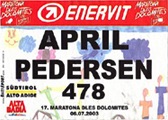
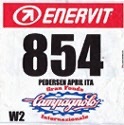
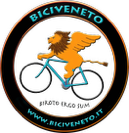
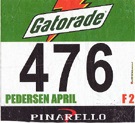
RIDING A GRANFONDO
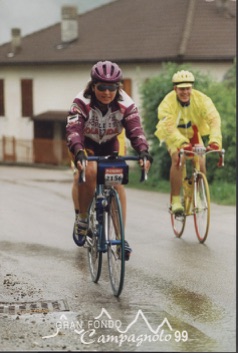
Here's what I would take for the Maratona dles Dolomites: thermal vest (every entrant gets one in their race pack!), arm warmers, Sportful Hot Pack No Rain jacket, and kneewarmers (the start is at 6:15 a.m. in a valley, with temperatures often in the 40's F--brrr! and the descent of the Passo Pordoi is still partially in shadow), If it's extra cold, long fingered gloves, lightweight shoe covers, and a Buff would be welcome additions. If rain were a possibility, I would add waterproof helmet and shoe covers. I dislike synthetic fabric undershirts, which are petroleum products and in effect, plastic; Mother Nature's own wool feels more snuggly, doesn't get clammy (or smelly), and keeps you warm even when it's wet. Remember that old proverb: there's no such thing as bad weather, only bad clothes! Cleat covers are useful for walking around at the feed stops. How to carry everything? Some options to consider are a small bikepacking bag, a top tube bag, a small handlebar bag, and a carry-all container that fits in your water bottle cage.
